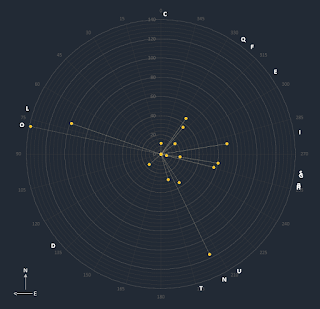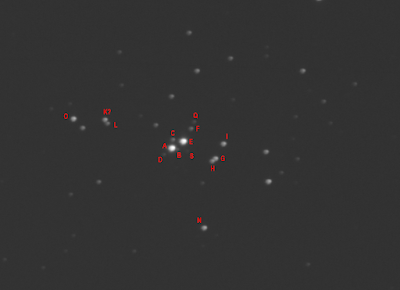| pair | PA | sep |
| AB | 256 | 6.1 |
| AC | 359 | 11.1 |
| AD | 131 | 16.1 |
| AE | 306 | 18 |
| AF | 320 | 36.2 |
| AG | 261 | 60.3 |
| AH | 256 | 57 |
| AI | 279 | 69.6 |
| AL | 71 | 98.3 |
| AN | 206 | 116.1 |
| AO | 78 | 138.9 |
| AQ | 325 | 45.6 |
| AS | 262 | 20.3 |
| AT | 196 | 27.5 |
| AU | 213 | 35.3 |
Oh. More stars. Not entirely surprised by that.
But no K; that's weird. There clearly is a pair at the L location. (At least, it is not listed with HS 2603.]
Or J. But that might be correct in that I don't see anything at the J location in SkyTools 3 Pro.
Generated a plot of the positions and separations with my latest generation spreadsheet.
The positions of B, C, E, F, H, I, L, N, and O look pretty good.
D is markedly different. WDS says this is close to A, to the south-east, at mag 14.1 as opposed to what SkyTools shows, with D near O. This faint star is visible in the image!
ST3P did not list a G star; WDS shows it near H. Ah ha, the tight pair in the photo. G is brighter at 9.6 and slightly further from A at 60.3" while H is mag 10.5 and 57.0". G is at an angle of 261 vs. 256 putting it north of H. This all checks out.
The WDS includes Q. It says this is north of F at mag 13.2. F is 11.7. This checks out too.
The S star is purportedly a mag 14.1 star beyond B. I think I have captured this in my image! Just barely visible.
The T and U elements from the WDS I do not see in the BGO photo. They are south-south-west of A. The USNO database says they are magnitude 15 stars. Ah. That's why.
While checking the double star database, I looked up the magnitude value for B. Oh, it's listed at 12.9. There you go. Rather dim. Which matches what I am seeing in the photo.
So, I think I have tagged all of the stars from the WDS save the extremely dim ones...
There is more data offered in the WDS but I did not review or cross-check these.
| Ea | 291 | 0.1 |
| EB | 146 | 14.2 |
| EC | 86 | 14.7 |
| EF | 334 | 18.6 |
| EG | 246 | 49 |
| EH | 240 | 47.1 |
| EI | 271 | 54 |
Interesting.




No comments:
Post a Comment